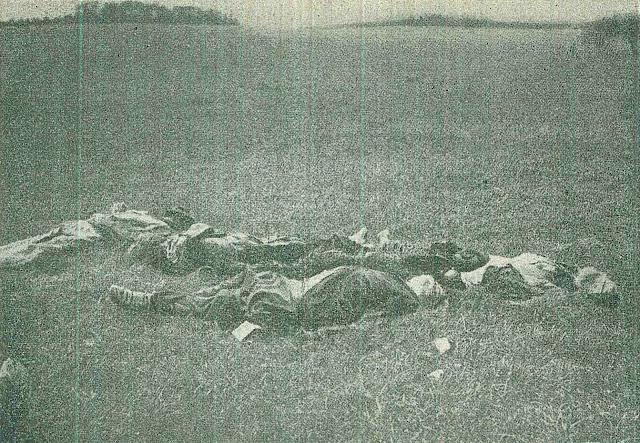In World War I, about 60 civilians were shot and massacred by the Germans on August 24, 1914 in an area called La Prele in Gerbevier, Belgium. Some of the people were taken to a field and shot dead. Civilians were murdered as they tried to flee their homes or burning buildings. In addition to the killings, countless acts of violence took place. (Photo reproduced from the report of the French Official Commission.)
The Germans invaded neutral Belgium on August 4, 1914, and starting on August 5, civilians were executed en masse as the invading forces invaded the first obstacle, a ring of fortifications around Liege. In retaliation for the shelling from these fortifications, the Germans killed the inhabitants of the surrounding villages. Victims were selected and shot, and those still alive were bayoneted to death. by August 8, nearly 850 civilians had been killed. By that time, certain abuses and massacres had been carried out. First, massacres occurred where the invasion forces had been foiled. The Germans considered the military defense of Belgium to be illegitimate. Second, the victims were mistakenly killed as civilian sniper soldiers. They mistakenly believed that local civilians were attacking the Germans. The delusion of civilians as snipers was chosen by the German commanders. Third, while some of the victims were women, children, and the elderly, the vast majority were civilians. The invading forces were outraged that the torn apart civilians were still enjoying life. Fourth, the massacre also brought with it a public ritual to show how helpless the civilians were. Civilians were always forced to support the army. Local dignitaries were publicly abused and in some cases murdered.
The German invasion of the Western Front began on August 18, and by August 28, the invasion force had crossed Belgium. By August 28, the invasion forces had crossed Belgium, and in the intervening ten days, the worst massacres had been carried out. The troops, exhausted from the forced marches and often under the influence of alcohol, committed massacres. Towns and villages were looted and burned, and survivors were deported. The hardest hit areas were Aartscourt on August 19 and Andanne on August 20. On August 22, Taminne, a small industrial city on the Meuse River, had about 383 residents killed. On August 23, in Dinan, the worst massacre of the invasion killed about 674 people, about one in ten residents. In the university town of Louvain, some 248 civilians were killed when the valuable university library was burned to the ground. Further south, hundreds of people were executed in the Belgian Ardennes. Snipers were killed in groups of about ten. The last were made to climb a mound of corpses to be shot. Similar killings, albeit on a smaller scale, were executed in invaded France. The first civilians were shot dead north of the Moselle River on August 9. Among other massacres, about 60 people were killed in Gerbevier, a large village in Lorraine, on August 24. The invading forces emphasized their superiority through massacres. In the small town of Werftel, north of Louvain, where the victims of the mass executions were buried, a triumphal arch was erected with the inscription "To the Victorious Warriors.

